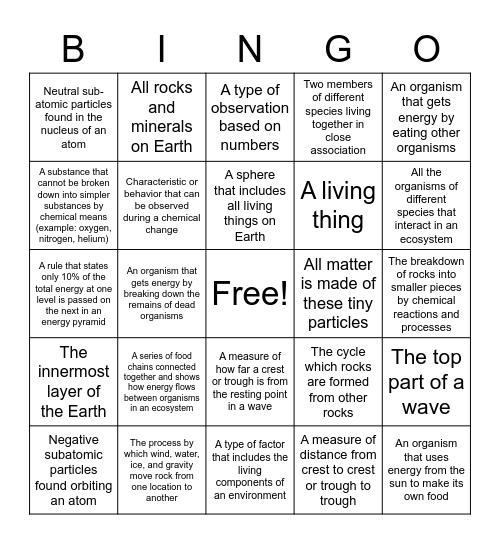

This bingo card has a free space and 82 words: Data (information) collected when using our senses, An educated guess based off of observations, A type of observation based on numbers, A type of observation based on describing characteristics, Anything that takes up space and has mass, The measure of the amount of molecules (matter) in an object, The effect gravity has on the mass of an object, The relationship between mass and volume; how closely packed the molecules are, The measure of how much space an object takes up, A procedure used to measure the volume of an object by placing it in liquid, Density = mass divided by volume, Characteristics that can be measured or observed without the matter changing into a new substance, Characteristic or behavior that can be observed during a chemical change, All matter is made of these tiny particles, Positive sub-atomic particles found in the nucleus of an atom, Neutral sub-atomic particles found in the nucleus of an atom, Negative subatomic particles found orbiting an atom, A substance that cannot be broken down into simpler substances by chemical means (example: oxygen, nitrogen, helium), Contains atoms of two or more different elements (example: H20), Contains two or more substances that are NOT bonded together, Two or more atoms bonded together (example: H2 or NaCl), A living thing, An organism that uses energy from the sun to make its own food, An organism that gets energy by eating other organisms, An organism that gets energy by breaking down the remains of dead organisms, A community of organism and on-living things, A series of organisms where each organism is dependent on the next as a food source, A consumer that only eats plants (herbivore), A consumer that eats primary consumers, A consumer that eats secondary consumers, A series of food chains connected together and shows how energy flows between organisms in an ecosystem, A pyramid that shows the available energy at each "level" in an ecosystem, A rule that states only 10% of the total energy at one level is passed on the next in an energy pyramid, A chemical reaction that producers go through to make food, A chemical reaction that all living things do to get energy, A type of factor that includes the living components of an environment, A type of factor that includes the non-living components of an environment, A large region of land with similar biotic and abiotic factors, All the organisms of different species that interact in an ecosystem, All members of a species within an ecosystem, Closely related organisms of one type, Two members of different species living together in close association, A type of symbiosis where one species benefits and one is not harmed or helped, A type of symbiosis where both species benefit, A type of symbiosis where one species benefits and the other is harmed, All rocks and minerals on Earth, A sphere that includes all water on Earth, A sphere that includes all living things on Earth, A sphere that includes all gasses in a layer that surrounds Earth, The process which rocks break down, The breakdown of rocks into smaller pieces by a physical force, The breakdown of rocks into smaller pieces by chemical reactions and processes, The process by which wind, water, ice, and gravity move rock from one location to another, The process where rock materials are dropped to the ground, A solid, naturally occurring inorganic with a crystal structure, A solid made from different combinations of minerals, A type of rock formed by heat and pressure, A type of rock formed by melted rock that is cooled, A type of rock formed by weathering, erosion, deposition, and compaction, The cycle which rocks are formed from other rocks, The outer layer of the Earth, The middle layer of the Earth, The innermost layer of the Earth, The interaction of the rigid lithospheric plates as they slide slowly over the mantle; plates moving, A type of boundary when tectonic plates being pushed together, A type of boundary when tectonic plates sliding past each other, A type of boundary when tectonic plates are pulled apart, The movement in the mantle that drives plate movement caused by a type of heat transfer, A single or repeated disturbance that transfers energy from one place to another, Anything that energy can travel through, A type of wave that causes particles to move up and down, A type of wave that causes particles to side to side, A measure of how far a crest or trough is from the resting point in a wave, A measure of distance from crest to crest or trough to trough, A measure of how many wave cycles in a second, A type of mechanical, longitudinal wave caused by the vibrations of particles in a medium, What a wave travels through; example: air or water, A type of wave that require a medium to travel; like a sound wave, Related to how loud or quiet a sound is; related to amplitude, Highness or lowness of a tone; related to frequency, The top part of a wave and The bottom part of a wave.
7th Grade Science Vocabulary Bingo | 7th Grade Science Vocabulary Bingo | 7th Grade Science Vocabulary Bingo | 7th Grade Science Vocabulary Bingo | 7th Grade Science Vocabulary Bingo
Share this URL with your players:
For more control of your online game, create a clone of this card first.
Learn how to conduct a bingo game.
With players vying for a you'll have to call about __ items before someone wins. There's a __% chance that a lucky player would win after calling __ items.
Tip: If you want your game to last longer (on average), add more unique words/images to it.